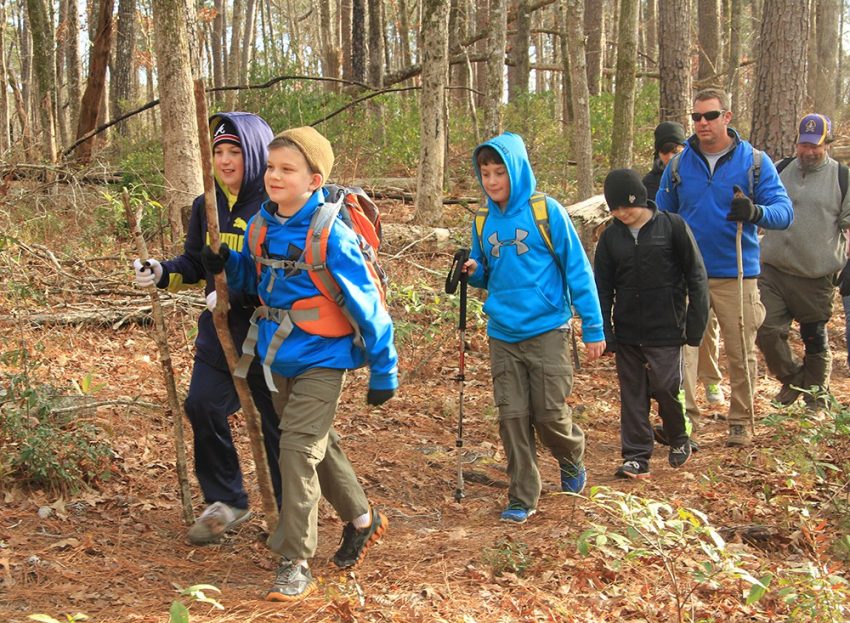When Debbie Gulledge worked at the Philmont Training Center in the 1990s, she went hiking weekly with Webelos Scout to Philmont’s fossilized Tyrannosaurus rex footprint. The first week, she recalls, the boys spent the entire hike looking at the ground and talking about their favorite movies — though they did find the T. rex print to be pretty cool.
Before her second hike, Gulledge, who lives in Lehi, Utah, had educated herself about the trail and its surroundings. She was able to show her next group of hikers deer scat, beaver tracks and wildflowers like Indian paintbrush. The result: They saw more than just the tops of their shoes. Things only got better.
At the end of the summer, she says, “By the time they got to the T. rex print, they had all this knowledge about the whole trail.”
Whether your next Cub Scout hike leads to a T. rex print, a waterfall or nothing more exciting than the parking lot, you’ll want to use Gulledge’s tips for helping boys find
joy in the journey.
Make an Attitude Adjustment
Gulledge cringes when she hears trainers say “What boy wouldn’t want to do this?” Her reaction: “I can name quite a few boys who don’t want to shoot BB guns and don’t want to go on a nature hike and don’t want to traverse a creek bed. There are so many other distractions vying for their time, a lot of them of the electronic variety.”
That means you might need to sell boys on the idea that they’ll get something out of a hike, whether that’s fun, knowledge or a sense of accomplishment. You might also need to sell yourself. If you’re convinced that spiders are icky and ants are creepy, your Scouts will pick up on your anxiety. “Before they even get outside, they’ve adopted your prejudice; now spiders are gross and ants are to be stepped on,” she says. “You need to be quiet about those things and let kids make their own opinions.”
Find a Focus
As you plan each hike, decide what its focus will be. Sure, you’ll encounter fun surprises along the way, but you need an idea of places where you’ll stop and activities you’ll do. That could mean hiking the trail ahead of time, as Gulledge did at Philmont, but it could also mean doing a little research before the trip. (See the sidebar for a list of easy hike themes.)
Once, for example, Gulledge led what she called a “circle of life” hike. The Lion King had just come out, and she knew her Scouts had been learning about food chains and food webs in school. Near the end of the hike, the group came across a deer skeleton, giving her the chance to talk about the role of predators and decomposers in the circle of life. “First, it was a predator, and then flies and fungi and mold did the rest,” she explained to the boys. “And now we’re left with this beautiful skeleton.”
Grab Your Toolkit
Boys tend to focus best when they have objects in their hands. And when those objects enhance the learning process? Even better.
Gulledge recommends supplying magnifying glasses and encouraging boys to study nature up close. You can also go to the other extreme and show your Scouts how to explore nature with binoculars.
Another handy tool: gloves. Gulledge recalls a hike in which the guide put on gloves and used a stick to tear open some moose droppings. “Your first reaction is, ‘Wow, this lady is touching poop,’ but then you look inside and say, ‘I didn’t realize this is what the diet of a moose is,’ ” she says.
Gather Your Resources
If you don’t know a pine tree from a pine warbler, recruit a parent, a member of your chartered organization or a local naturalist to accompany you on your hikes. Some of your older boys might even be able to help. “If they know something, let them teach,” she says. “That gives such a huge boost to their self-esteem.”
Even if you go unassisted, you don’t have to be an expert. “It’s good for boys to understand that you don’t know everything,” Gulledge says. “That gives them confidence that they don’t have to know everything.”
Nature Hike Themes
Alphabet Hike: Look for objects in nature that start with each letter of the alphabet.
Circle Hike: Draw a 1-foot circle on the ground and count the living things inside.
Five Senses Hike: At prearranged stations, set up activities that use the five senses. (Anything boys taste, though, should probably be brought from home.)
Flashlight Hike: Head out at night to discover nature after dark. If possible, hike the same trail during the day and again at night.
Paint Chip Hike: Bring along assorted paint cards from the hardware store and try to find things in nature that match the colors.



